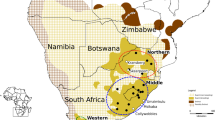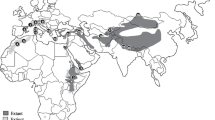Abstract
Populations of Oriental White-backed Vulture (Gyps bengalensis) and Long-billed Vulture (Gyps indicus) dramatically declined by 95–100% on the Indian subcontinent in mid-1990s. The present study was conducted to discover the phylogeny and phylogeography of Gyps species based on nuclear (recombination activating gene, RAG-1) and mitochondrial (cytochrome b, cytb) markers. Gyps species showed monophyly and no geographic partition was observed within the three groups of Gyps species (G. bengalensis, G. indicus and G. fulvus) despite the large sample size available (n = 149). Our study supports the treatment of G. indicus and G. tenuirostris as separate species. In all analyses, the earliest divergence separated G. bengalensis from all other Gyps taxa while a sister relationship was supported between G. fulvus and G. rueppellii, and these two taxa together were sister group to a clade consisting of G. indicus, G. tenuirostris and G. coprotheres. Molecular clock estimates of both nuclear and mitochondrial (RAG-1, cytb) genes indicated a rapid and recent diversification within the Gyps species.




Similar content being viewed by others
References
Altekar G, Dwarkadas S, Huelsenbeck JP, Ronquist F (2004) Parallel metropolis–coupled Markov chain Monte Carlo for Bayesian phylogenetic inference. Bioinformatics 20:407–415
Amadon D (1977) Notes on the taxonomy of vultures. Condor 79:413–416
Arctander P, Johanson C, Coutellec-Vreto MA (1999) Phylogeography of three closely related African bovids (tribe Alcelaphini). Mol Biol Evol 16:1724–1739
Bandelt HJ, Forster P, Rbhl A (1999) Median-joining networks for inferring intraspecific phylogenies. Mol Biol Evol 16:37–48
Brown LH, Amadon D (1968) Eagles, hawks and falcons of the world. Country Life Books, London
del Hoyo J, Elliott A, Sargatal J (1994) Handbook of the birds of the world, vol 2. Barcelona: Lynx edicions
de Menocal PB (1995) Plio–Pleistocene African climate. Science 270:53–59
de Menocal PB (2004) African climate change and faunal evolution during the Pliocene–Pleistocene. Earth Planet Sci Lett 220:3–24
Dietzen C, Witt H-H, Wink M (2003) The phylogeographic differentiation of the European robin Erithacus rubecula on the Canary Islands revealed by mitochondrial DNA sequence data and morphometrics: evidence for a new robin taxon on Gran Canaria? Avian Sci 3:115–131
El-Sayed AA (2007) Phylogenetic relationships of diurnal raptors based on nucleotide sequences of cytochrome b and RAG-1 genes. PhD dissertation, University of Heidelberg, Germany
Ferguson-Lees IJ, Christie DA (2001) Raptors of the world. Christopher Helm, London
Fritz U, Auer M, Bertolero A, Cheylan M, Fattizzo T, Hundsdörfer AK, Sampayo MM, Pretus JL, Široký P, Wink M (2006) A rangewide phylogeography of Hermann’s tortoise, Testudo hermanni (Reptilia: Testudines: Testudinidae): implications for taxonomy. Zool Scripta 35:531–543
Gilbert M, Virani MZ, Watson RT, Oaks JL, Benson PC, Khan AA, Ahmed S, Chaudhary J, Arshad M, Mahmood S, Shah QA (2002) Breeding and mortality of Oriental white–backed vulture Gyps bengalensis in Punjab Province, Pakistan. Bird Conserv Int 12:311–326
Griffiths CS, Barrowclough GF, Groth JG, Mertz LA (2007) Phylogeny, diversity and classification of the Accipitridae based on DNA sequences of the RAG-1 exon. J Avian Biol 38:587–602
Groth JG, Barrowclough GF (1999) Basal divergences in birds and the phylogenetic utility of the nuclear RAG-1 gene. Mol Phylogenet Evol 12:115–123
Grubh RB, Narayam G, Satheesan SM (1990) Conservation of vulture in India. In: Daniel JC, Serrao JS (eds) Bombay natural history society. Oxford University Press, Oxford
Hall T (2004) BioEdit: version 7.0.0. Ibis Therapeutics, Carlsbad, CA
Handschuh M (2007) Schutzbemühungen für kritisch bedrohte Geier in Kambodscha. ZGAP 2:3–5
Helbig AJ, Kocum A, Seibold I, Braun MJ (2005) A multi-gene phylogeny of aquiline eagles (Aves: Accipitriformes) reveals extensive paraphyly at the genus level. Mol Phylogenet Evol 35:147–164
Houston DC (1974) Food searching in griffon vultures. East Afr Wildl J 12:63–77
Houston DC (1983) The adaptive radiation of the griffon vultures. In: Wilbur SR, Jackson JA (eds) Vulture biology and management. University of California Press, Berkeley, pp 360–363
Houston DC (1985) Indian white–backed vulture (G. bengalensis). In: Newton I, Chancellor RD (eds) Conservation studies on raptors, technical publication no. 5 International council for bird preservation, Cambridge, UK. pp 465–466
Hume AO (1869) My scrap book: or rough notes on Indian zoology and ornithology. Baptist Mission Press, Calcutta
Hume AO (1873) Contributions to the ornithology of India, Sindh. Stray Feathers 1:91–289
Irestedt M, Johansson Ulf S, Parsons Thomas J, Ericson Per GP (2001) Phylogeny of major lineages of suboscines (Passeriformes) analysed by nuclear DNA sequence data. J Avian Biol 32:15–25
IUCN (2006) IUCN red list of threatened species. http://www.iucnredlist.org
Jacobs BF, Kingston JD, Jacobs LL (1999) The origin of grass dominated ecosystems. Ann Mo Bot Gard 86:590–643
Jerdon TC (1871) Supplementary notes to the birds of India. Ibis 1:234–247
Johnson JA, Lerner HRL, Rasmussen PC, Mindell DP (2006) Systematics within Gyps vultures: a clade at risk. BMC Evol Biol 6:65
Karl SA, Bowen BW (1999) Evolutionary significant units versus geopolitical taxonomy: molecular systematics of an endangered sea turtle (genus Chelonia). Conserv Biol 13:990–999
Kocher TD, Thomas WK, Meyer A, Edwards SV, Paabo S, Villablanca FX, Wilson AC (1989) Dynamics of mitochondrial DNA evolution in animals: amplification and sequencing with conserved primers. Proc Natl Acad Sci USA 86:6196–6200
Lerner HRL, Mindell DP (2005) Phylogeny of eagles, Old World vultures, and other Accipitridae based on nuclear and mitochondrial DNA. Mol Phylogenet Evol 37:327–346
Lovette IJ (2004) Mitochondrial dating and mixed support for the 2% rule in birds. Auk 121:1–6
Matthee CA, Davis SK (2001) Molecular insights into the evolution of the family Bovidae: a nuclear DNA perspective. Mol Biol Evol 18:1220–1230
Mindell DP, Thacker CE (1996) Rates of molecular evolution: phylogenetic issues and applications. Annu Rev Ecol Syst 27:279–303
Mundy P, Butchart D, Ledger J, Piper S (1992) The vultures of Africa. Academic Press, London
Oaks JL, Gilbert M, Virani MZ, Watson RT, Meteyer CU, Rideout BA, Shivaprasad HL, Ahmed S, Chaudhry MJI, Arshad M, Mahmood S, Ali A, Khan AA (2004) Diclofenac residues as the cause of vulture population decline in Pakistan. Nature 427:630–632
Pain DJ, Cunningham AA, Donald PF, Duckworth JW, Houston DC, Katzner T, Parry-Jones J, Poole C, Prakash V, Round P, Timmins R (2003) Causes and effects of temporospatial declines of Gyps vulture in Asia. Conserv Biol 17:661–671
Pereira SL, Baker AJ (2006) A mitogenomics timescale for birds detects variable phylogenetic rates of molecular evolution and refutes the standard molecular clock. Mol Biol Evol 23:1731–1740
Posada D, Crandall KA (1998) Model test: testing the model of DNA substitution. Bioinformatics 14:817–818
Purvis A, Gittleman JL, Brooks T (2005) Phylogeny and conservation. Cambridge University Press, Cambridge
Rasmussen PC, Anderton JC (2005) Birds of South Asia, the Ripley Guide, vol 2: attributes and status. Smithsonian Institute, Washington DC
Rasmussen PC, Clark WS, Parry SJ (2001) Field identification of Long–billed Vulture (Indian and slender–billed vultures). Orient Bird Club 34:24–29
Ronquist F, Huelsenbeck JP (2003) MrBayes 3: Bayesian phylogenetic inference under mixed models. Bioinformatics 19:1572–1574
Sambrook J, Russell DW (2001) Molecular cloning. A laboratory manual. Cold Spring Harbor Laboratory Press, New York
Seibold I, Helbig AJ (1995) Evolutionary history of New and Old World vultures inferred from nucleotide sequences of the mitochondrial cytochrome b gene. Philos Trans R Soc Lond B 350:163–178
Shields GF, Wilson AC (1987) Calibration of mitochondrial DNA evolution in geese. J Mol Evol 24:212–217
Shultz S, Baral HS, Charman S, Cunningham AA, Das D, Ghalsasi GR, Goudar MS, Green RE, Jones A, Nighot P, Pain DJ, Prakash V (2004) Diclofenac poisoning is widespread in declining vulture population across the Indian subcontinent. Proc R Soc Lond B 271:458–460
Sorenson MD, Ast JC, Dimcheff DE, Yuri T, Mindell DP (1999) Primers for a PCR-based approach to mitochondrial genome sequencing in birds and other vertebrates. Mol Phylogenet Evol 12:105–114
Swan GE, Naido V, Cuthbert R, Green RE, Pain DJ, Swarup D, Prakash V, Taggart M, Bekker L, Das D, Diekmann J, Diekmann M, Killian E, Meharg A, Patra RC, Saini M, Wolter K (2006) Removing the threat of diclofenac to critically endangered Asian vultures. Plos Biol 4:e66
Swofford DL (2002) PAUP*, phylogenetic analysis using parsimony (and other methods), version 4.0b10a. Sinauer, Sunderland
Tamura K, Nei M (1993) Estimation of the number of nucleotide substitutions in the control region of mitochondrial DNA in humans and chimpanzees. Mol Biol Evol 10:512–526
Tamura K, Dudley J, Nei M, Kumar S (2007) MEGA4: molecular evolutionary genetics analysis (MAGA) software version 4.0. Mol Biol Evol 24:1596–1599
Thiollay JM (1994) Family Accipitridae (hawks and eagles). In: del Hoyo J, Elliott A, Sargatal J (eds) Handbook of the birds of the world. Lynx Ediciones, Barcelona, pp 52–205
Vrba ES (1985) African Bovidae: evolutionary events since the Miocene. S Afr J Sci 81:263–266
Wink M (1995) Phylogeny of Old and New World vultures (Aves: Accipitridae and Cathartidae) inferred from nucleotide sequences of the mitochondrial cytochrome b gene. Z Naturforsch 50c:868–882
Wink M, Sauer-Gürth H (2004) Phylogenetic relationships in diurnal raptors based on nucleotide sequences of mitochondrial and nuclear marker genes In: Chancellor RD, Meyburg BU (eds) Raptors worldwide. WWGBP, Berlin, pp 483–498
Wink M, Kuhn M, Sauer-Gürth H, Witt H-H (2002) Ein Eistaucher (Gavia immer) bei Düren–Fundgeschichte und erste genetische Herkunftsuntersuchungen. Charadrius 38:239–245
Acknowledgments
This Project was supported by a fellowship of the Deutscher Akademischer Austausch Dienst to M.A. We are very grateful to many people who helped us with the field work, especially the Ministry of Environment and Tourism Namibia for permission to collect and export the samples. We thank Hedi Sauer-Gürth for her help in the laboratory as well as Theodor C. H. Cole for improving this manuscript. We thank Prof. Dr. H. Bock (Managing Director of IWR) and S. Friedel for access to parallel computing facilities at the interdisciplinary center for Scientific Computing (IWR, Heidelberg University). Finally, we greatly appreciate the constructive comments of anonymous referee to improve the final manuscript.
Author information
Authors and Affiliations
Corresponding author
Additional information
Communicated by J. Fjeldså.
Electronic supplementary material
Below is the link to the electronic supplementary material.
10336_2008_359_MOESM1_ESM.xls
Origin, collection codes and accession numbers of taxa sequenced in this study. Haplotype names correspond to those in Fig. 4 (XLS 44 kb)
Rights and permissions
About this article
Cite this article
Arshad, M., Gonzalez, J., El-Sayed, A.A. et al. Phylogeny and phylogeography of critically endangered Gyps species based on nuclear and mitochondrial markers. J Ornithol 150, 419–430 (2009). https://doi.org/10.1007/s10336-008-0359-x
Received:
Revised:
Accepted:
Published:
Issue Date:
DOI: https://doi.org/10.1007/s10336-008-0359-x




